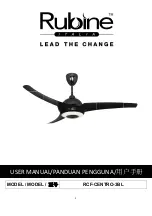
Operating instructions
D4E225-DH01-01
Translation of the original operating instructions
3.5 Mounting data
Strength class of
screws
8.8
For screw clearance, see Chapter 3.1 Product drawing
;
Secure the screws against unintentional loosening (e.g. use self-
locking screws).
Any further mounting data required can be taken from the product
drawing or Section Chapter 4.1 Mechanical connection.
3.6 Transport and storage conditions
Max. permitted
ambient temp. for
motor (transport/
storage)
+ 80 °C
Min. permitted
ambient temp. for
motor (transport/
storage)
- 40 °C
4. CONNECTION AND STARTUP
4.1 Mechanical connection
CAUTION
Cutting and crushing hazard when removing blower
from packaging
→ Carefully remove the blower from its packaging, touching
only the housing. Strictly avoid shocks.
→ Wear safety shoes and cut-resistant safety gloves.
CAUTION
Heavy load when unpacking device
Risk of physical injury, such as back injuries.
→ Two people should work together to remove the device from
its packaging.
NOTE
Damage to the device from vibration
Bearing damage, shorter service life
→ The fan must not be subjected to force or excessive vibration
from sections of the installation.
→ If the fan is connected to air ducts, the connection should
be isolated from vibration, e.g. using compensators or similar
elements.
→ Ensure stress-free attachment of the fan to the
substructure.
;
Check the device for transport damage. Damaged devices are not to
be installed.
;
Install the undamaged device in accordance with your application.
NOTE
Motor capacitor
→ The product is equipped with a motor capacitor with safety
protection class P0/S0 according to EN 60252-1. Take this
into consideration when fitting it to the end product on the
basis of applicable regulations.
CAUTION
Possible damage to the device
If the device slips during installation, serious damage can result.
→ Ensure that the device is securely positioned at its place of
installation until all fastening screws have been tightened.
●
The fan must not be strained on fastening.
4.2 Electrical connection
DANGER
Voltage on the device
Electric shock
→ Always connect a protective earth first.
→ Check the protective earth.
DANGER
Faulty insulation
Risk of fatal injury from electric shock
→ Use only cables that meet the specified installation
regulations for voltage, current, insulation material, capacity,
etc.
→ Route cables so that they cannot be touched by any
rotating parts.
DANGER
Electrical charge (>50 µC) between phase conductor and
protective earth connection after switching off supply
with multiple devices connected in parallel.
Electric shock, risk of injury
→ Ensure sufficient protection against accidental contact.
Before working on the electrical hookup, short the supply
and PE connections.
CAUTION
Voltage
The device is a built-in component and has no disconnecting
switch.
→ Only connect the device to circuits that can be switched off
with an all-pole disconnection switch.
→ When working on the device, secure the system/
machine in which the device is installed so as to prevent it
from being switched back on.
NOTE
Water ingress into wires or cables
Water ingress at the customer end of the cable can damage the
device.
→ Make sure the end of the cable is connected in a dry
environment.
Only connect the device to circuits that can be switched off with
an all-pole disconnection switch.
Item no. 11627-5-9970 · ENU · Change 210738 · Approved 2020-02-27 · Page 6 / 11
ebm-papst Mulfingen GmbH & Co. KG · Bachmühle 2 · D-74673 Mulfingen · Phone +49 (0) 7938 81-0 · Fax +49 (0) 7938 81-110 · [email protected] · www.ebmpapst.com





























